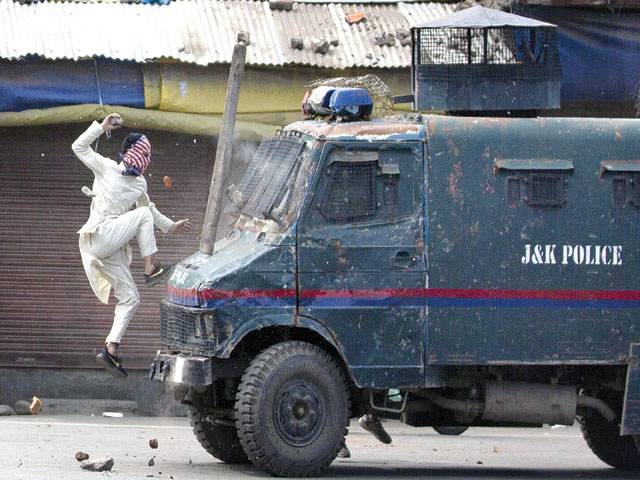Pakistan and India have jointly administered the Jammu and Kashmir region since 1948, when the United Nations negotiated a cease-fire between the two South Asian countries and decreed that the Kashmiri people would determine their own future. That there is a hotly disputed region adjoining two nuclear-armed adversaries should be momentous enough to engage the United States in resolving the matter.
Not only could the conflict go nuclear, but American security and economic interests are also at risk. Both India and Pakistan are important trading partners, and Afghanistan -- once a source of terrorist attacks against the United States and today the scene of America’s longest war -- lies at the heart of the region.
The United States is at last showing interest, precipitated by a crisis. Recently, the House Foreign Affairs Subcommittee on Asia, the Pacific, and Nonproliferation held a hearing on the state of human rights in Jammu and Kashmir. The hearing follows an Aug. 5 announcement by India that it would no longer adhere to the articles that gave Kashmir its special independent status. India then deployed tens of thousands of troops to the region. It imposed a communications lockdown and curfew on the nearly 8 million Kashmiris living in the disputed region. More recently, India has begun breaking up the region into smaller areas and annexing them.
Since then, even though no foreign or independent media are allowed to visit the region, stories of human rights violations, the arrests of thousands of Kashmiris, and torture have still trickled out, causing understandable concern -- including on Capitol Hill.
At the hearing, Amnesty International’s Francisco Bencosme noted, “It’s completely unthinkable that you will detain children, political leaders and youth adults, close down all communication, put people under a curfew to bolster tourism in the region.”
Many of the members of Congress at the Oct. 22 hearing expressed concern and outrage at the situation. Chairman Brad Sherman conceded that Kashmir was “the most dangerous geopolitical flash-point in the world.” Yet, escalating tensions on the Line of Control separating Indian and Pakistani administered Kashmir, including Indian troops firing across it, continue unabated.
When we served in the US Congress, the United States understood the meaning and value of promoting and protecting freedom, democracy, and human rights. If these values are weak anywhere, they are weak everywhere. The situation in Kashmir represents a breakdown in those values.
In fairness, President Donald Trump and members of Congress from both sides of the aisle have encouraged a peaceful solution. President Trump has made it known more than once -- including during meetings this summer with Pakistani Prime Minister Imran Khan and with Indian Prime Minister Narendra Modi -- that he was ready to help de-escalate tensions and mediate a settlement of this longstanding issue
Kashmir is not just an internal matter for one or the other country to manage. Kashmir has already sparked wars between India and Pakistan. It can easily animate another one -- but this time a conflict between nuclear-armed nations. This at a time when our own presence in the region is in flux as we try to end the war in Afghanistan. The situation in Kashmir -- and its long-term solution -- deserves a multilateral approach, led by the United States.
The recent hearing in Congress at least gets a toe in the water. But many questions remain, perhaps the most critical and urgent being whether the Trump administration has undertaken a serious analysis of the implications of an armed conflict between Pakistan and India. Pakistan has already stated its willingness to defend Kashmiris, while India has made statements regarding its first-use policy of nuclear weapons. Are we really going to ignore the most militarized region on earth?
We hope not. America’s leadership is under threat and being questioned. Our diplomatic, moral, economic and political leadership is being undermined by a thousand little cuts. As The New York Times noted in its recent editorial on Kashmir, one reason behind the United Nations’ lack of action on Kashmir is an overall decline in American leadership.
Let’s hope Kashmir becomes a symbol of America’s moral influence on the world, not another example of the failure of our leadership.
First elected in 1987, Representative Chris Shays served as the Congressman for the Stamford, Conn., area for more than 20 years. He and his wife Betsi, both former members of the Peace Corps stationed in Fiji, maintain their dedication to public service today, with Shays having served on the board of directors of a management and technology consulting firm, as well as in a commissioner role with UNESCO, since his time in Washington. From the Long Island area, Representative George Hochbrueckner first served as Congressman for New York’s First District in 1986. Retiring from his elected official responsibilities after nearly a decade on Capitol Hill and five terms in the New York State Assembly, Hochbrueckner still works to bring accessibility to Washington as a policy consultant and continues to give back to the community. He and his wife Carol are currently based in Suffolk County, where Hochbrueckner serves as a Member of the Middle County Library Foundation Board, working to develop services and programs to libraries across the US The views expressed are the authors’ own.
Courtesy: www.realclearworld.com






